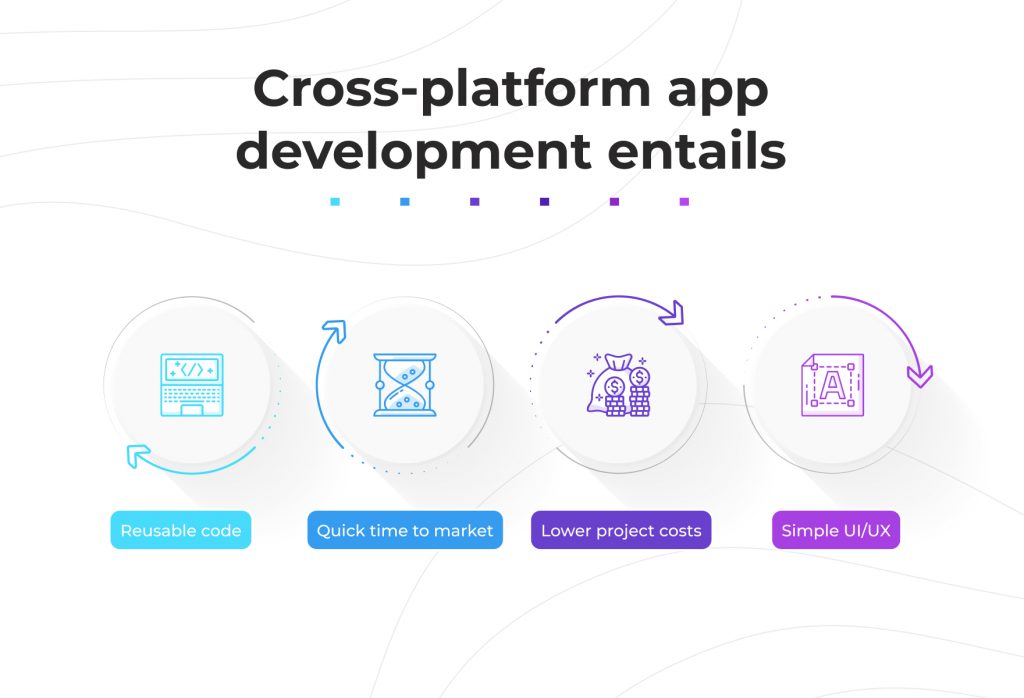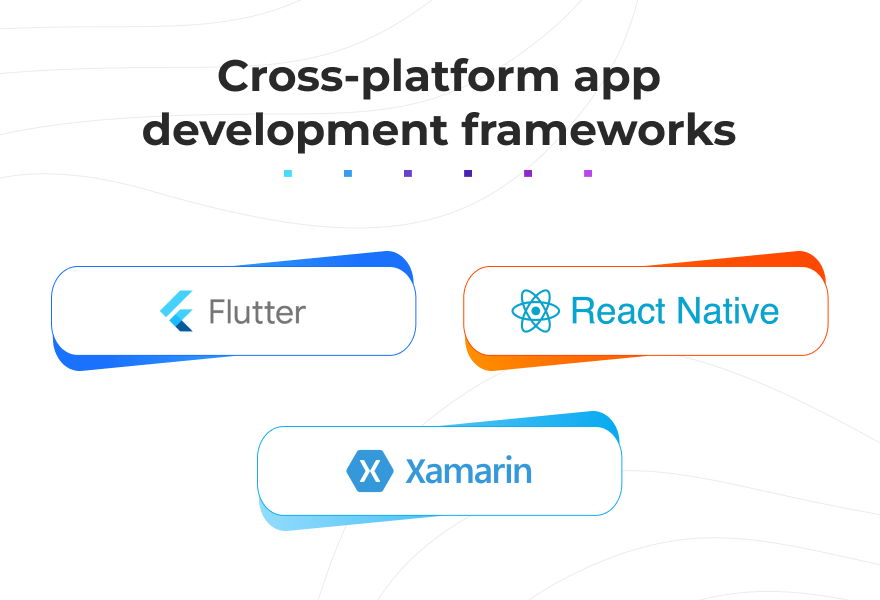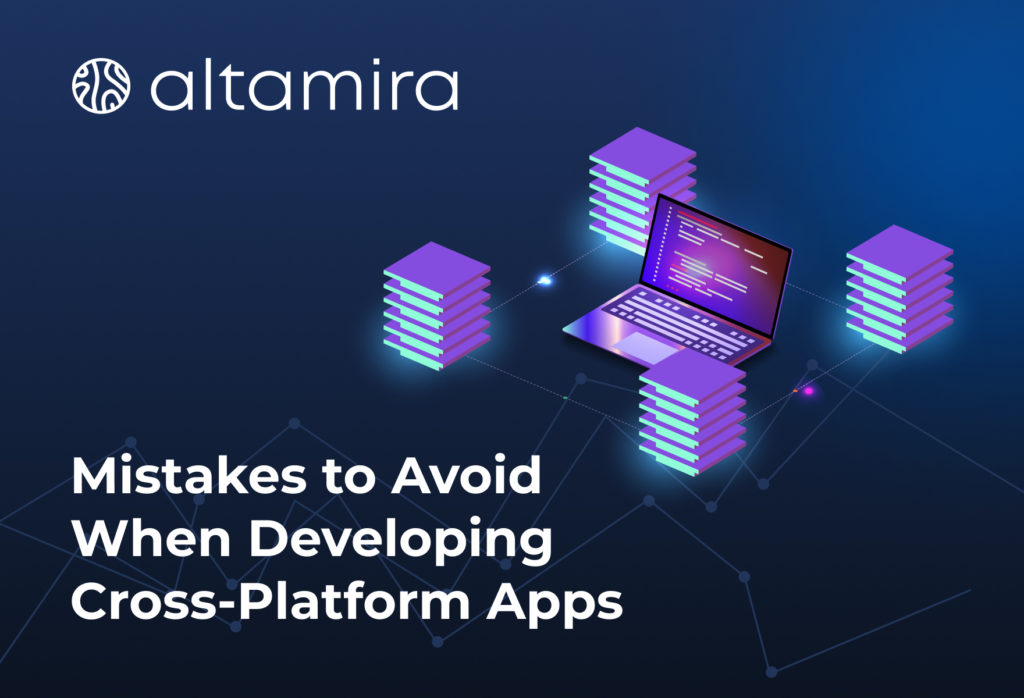Table of Contents
In the modern constantly evolving market of mobile apps, businesses don’t lose the chance to expand their business presence, meaning developing the mobile apps that are available for various operating systems and marketplaces.
Cross-platform app development becomes the priority development approach among companies, instead of the market. Therefore, in this article, we want to explore the main differentiators of cross-platform app development that highlight it from other development approaches and also share the best practices that will help the dev teams and project stakeholders avoid lots of mistakes during the development process.
Native vs cross-platform apps: what is the difference?
Before we start discussing the difference between native and cross-platform apps, we would like to determine the definition of these two types of mobile app development and outline their features and peculiarities
Native app development
Native app development is a mobile solution that is feasible only for a certain operating system, meaning only Android or only iOS, and so on. Thus, the applied programming languages and frameworks are also different depending on what system you need the app to be done for, for instance, Java and Kotlin for Android-based solutions and Swift or Objective-C for iOS-based applications. Hence, if you want to submit your app development to various marketplaces, you require cross-platform app development, instead of a native development approach.
Cross-platform app development
Cross-platform app development entails building the application within a single codebase for the purpose of making it available for different operating systems. Cross-platform development requires applying other specific frameworks produced by globally known companies like Google, Microsoft, and others, and we will discuss them in detail later in this post. Despite the cross-platform app being available on various operating systems, it needs to feel native on every OS it is feasible on, applying native UI methods.
Native vs cross-platform apps
Summing up the definitions of native and cross-platform app development, it is time to ask the main question—what the difference between these two development approaches is, and what kind of mobile apps is supposed to be more profitable or on the contrary?
The selection of one or another approach completely depends on the ongoing business needs and capabilities, according to the budget and timeline. Here are the main indicators you need to consider when picking the type of mobile app that is a better match.

Delivery process
If you want to launch a mobile app as soon as possible and quickly develop an MVP version during the next 3 months, then cross-platform app development is the best choice. You develop only one solution that will be available on different OSs while the native app development approach requires different solutions for each operating system.
Project expenses
Native apps are known for great performance as the dev team considers all peculiarities of each operating system it is developed for. However, the native development approach requires a broader project budget than cross-platform app development to build, for instance, two different apps for Android and for iOS. Hence, if you have a limited budget or the upcoming mobile solution is your startup idea, then a cross-platform development approach is your choice.
UI/UX approach
Native development allows the development team to have full access to UI/UX elements and produce an appealing and powerful, unique mobile app design. If we view cross-platform app development, the dev team is going to meet certain limits in the design elements that can be applied to the app.
Common cross-platform app development mistakes
Talking about the cross-platform mobile development approach, the development teams face lots of challenges and risks that can be addressed under the condition of choosing a credible software provider. These mistakes may delay the project deadlines, result in the lacking functions that were expected, system bugs, etc. Further, we would like to discuss the common issues the developers struggle with in cross-platform app development and what solutions can prevent or resolve them quickly and effectively.
Design
The majority of mistakes are made in the UI because there are differences between IOS and Android. Android provides physical or virtual navigation buttons, but on iOS, we haven’t any physical or virtual buttons. Also, some elements like a calendar or date picker can have differences.
For example, on the Fitpool project, we had a bug when navigation buttons didn’t work properly because you haven’t the back hardware or virtual back button on your IOS device. The second problem happened when our customer asked us to make the same view for date pickers on iOS and Android – we found another bug: pickers on Android and IOS have different behavior.
Bug fixing
Fixing bugs on one platform produces new bugs on another platform. Sometimes when a developer fixes a bug, it will produce another bug. It happens due to the following reasons.
The difference in hardware and software
When we want to create an app, the time-to-time team can forget about differences between how specific hardware or software elements work, e.g., how security works on iOS and Android. When you open a list of background apps, your bank application will be blurred on iOS and not on Android. If your application should be secured, you must keep in mind this difference.
Not enough testing
People will make issues when you develop applications. The tester can decide not to test some piece of functionality on different platforms because “It works fine on iOS, so all will be ok on Android because it’s the same code for both platforms”. But, NO! You must test on all platforms, because things that work on iOS, couldn’t work on Android.
Altamira’s best practices to avoid mistakes in cross-platform mobile development
After years of experience in building mobile apps of different types, our team has managed to define the efficient practices of how to build cross-platform apps from scratch considering the potential risks and challenges and preventing the mistakes we mentioned above. It speeds up the development life cycle and saves clients money and effort.
Make UI appealing
Your app should look aesthetically and be attractive to all users, also your app must be considered on different platforms. Developers need to be familiar with all requirements and guidelines for multiple-platform mobile development before starting to build the app itself. There are many diversities when it comes to developing a cross-platform app. These can be simple or related to the overall usage of the app.
Choosing to use a very specific feature on one platform would destructively affect the overall app usage. This can be solved by acknowledging developers with all platforms scenarios to catch the most important features and to be able to perform these in a proper user-friendly way.
Minimalistic design approach
It’s good when your design is minimal because it makes your app easy to use for the users. Minimal design makes it easy to present relevant information.
Write readable and maintainable code
While we are working on implementation, we always use critical thinking to check if the code is readable by:
- Good modularization and hiding implementation behind small, well-documented interfaces
- Be consistent in naming all the variables, classes, fields, and methods
- Use comments throughout the code, but don’t overdo it
- Indent your code and keep the style consistent
- Covering code with different sets of automated tests, the major benefits of testing happen when you think about and write tests, not just when you run them
- We do unit tests covering different edge cases scenarios included
- E2E tests for the main flows
Make clean code
Sometimes your code is maintained by other developers, and you also may need to modify your code in the future for app updates. So it’s crucial to write clean code that is maintainable and readable. Some of the best practices for writing clean code include:
- Be consistent in naming all the variables, classes, fields, and methods
- Use comments throughout the code but don’t overdo it
- Indent your code and keep the style consistent
- Group your code
- Avoid too many levels of testing
Remember also to treat yourself as “another developer” too. In three years’ time, after 150 weeks of lunches and late-night TV, you’ll look at today’s code and wonder what on Earth it all means. Trust me. Comment for yourself – as if you never wrote the code in the first place.
Apply the right cross-platform development framework
Using the right cross-platform app builder helps make highly functional apps for multiple platforms and speeds up the development process. A good framework offers a set of easy-to-use visual controls that work with different types of devices. You should use a development framework that comes with all the features you need to create cross-platform apps.
Frameworks for cross-platform mobile development

Flutter
Google introduced an impressive cross-platform app framework named Flutter back in 2017. It is a software development kit designed to assist in expeditious Android and iOS app development. It is also a fundamental and primary method for developing Google apps. Flutter offers apps that easily and effectively run-on multiple platforms with uniformity and dynamic. Here are some of the remarkable features that make Flutter an ideal cross-platform framework for developers:
- Flutter promotes portable GPU, which renders UI power, allowing it to work on the latest interfaces.
- Flutter does not require updating the UI contents manually, as it possesses a reactive framework. Flutter app Developers are only required to update the variables and the UI changes will be visible after that.
- Flutter cross-platform app framework poses as a perfect choice for developing a Minimum Viable Product (MVP) as it initiates an expeditious development process and is also cost-efficient.
- The developers can efficiently remake a widget tree automatically and comprehend the code adjustments.
- Flutter has an inbuilt graphic engine. Along these lines, the developers would not have the headache of making separate interfaces for Android and iOS.
React Native
When talking about cross-platform app frameworks, it is hard not to include React Native. It is a framework built on JavaScript and is used to write real code and give a native-like feel to mobile applications that work both on Android and iOS. React Native integrates the benefits of JavaScript and React.JS along with providing the advantage to developers to write modules in Objective-C, Swift, or Java languages. Moreover, by using the native modules and libraries in the React Native cross-platform apps, developers can also perform heavy operations such as image editing, video processing, or some other operations which are not part of the framework APIs. The features of this framework are the next:
- It is a good thing that React Native is an open-source cross-platform app framework, the same as Ionic. Because of this, it has a large community to support it and improve it by fixing bugs, improvising, and introducing features.
- One of the advantages of cross-platform development is that it requires one-time coding (WORA) for developing apps for platforms as diverse as Android and iOS. This solves one of the biggest challenges of other frameworks – requiring developers to code separately twice for the same app on different platforms.
- One-time coding instantly reduces the development time of the app along with keeping the React Native app development cost at its lowest.
- Impressively, React Native is highly compatible with third-party plugins, such as Google Maps.
React Native focuses on UI to a great extent, rendering a highly responsive interface. What it means is that the React Native environment eliminates the time taken in loading and delivers a smooth interface to the applications.
Xamarin
Xamarin cross-platform mobile development frameworks are significantly different from the frameworks we have discussed so far. It is a streamlined framework used for developing apps for Android, Windows, and iOS with the help of C# and .Net, instead of JS libraries and HTML. It allows the developers to use 90% of the code for building an app for three distinct platforms.
Xamarin delivers applications with aesthetics like a native app with the help of its amazing APIs, something which makes the decision-making a lot harder between Xamarin vs React Native. Here are Xamarin’s features, explaining why it is one of the best choices of cross-platform development tools for Mobile Development:
- Apps developed on the Xamarin framework are built using C# – a modern cross-platform mobile development language having leverage over Objective-C and Java.
- The developers get native-level app functionality with Xamarin. It reduces hardware compatibility problems to a great extent with the help of plugins and specific APIs that work with standard devices’ functionality. It also promotes linking with native libraries, allowing customization and native-level functionality. The feature alone makes it one of the top Android app development frameworks.
- Xamarin supports a direct inclusion of Objective-C, Java, and C++ libraries. This allows developers to reuse many third-party codebases encrypted in Java, Objective-C, or C++, making it one of considerably the best cross-platform frameworks.
- Xamarin reduces the time and cost of mobile app development as it supports the WORA (Write Once, Run Anywhere) and has a humongous collection of class libraries.
- Xamarin offers robust compile-time checking. Because of this facility, developers witness fewer run-time errors and get well-functioning apps.
- Xamarin has an astounding native user interface and controls, assisting and allowing developers in designing a native-like app.
To wrap it all
Cross-platform app development has its advantages and disadvantages, which need to be explored and weighed before you decide what development approach is better for your case. Certainly, the cross-platform app required less time and investment to launch the solution and makes it functional on various operating systems. But it all depends on your current business requirements and capabilities. Due to our broad expertise in mobile app development, we propose you schedule a consultation with our experts to help you with specifying the core issues your business faces and pick the best development approach for your individual needs.
FAQ
What are the frameworks for cross-platform app development?
Cross-platform app development entails using certain frameworks that make the solution feasible and functional for various operating systems. Among the most known cross-platform app development frameworks, we would highlight Flutter, React Native, and Xamarin.
What are the benefits of cross-platform app development?
Cross-platform is just one approach to mobile app development which is beneficial for a range of businesses, depending on the current needs and requirements. To mention a few benefits of cross-platform app development, we would say speeded up the development process as you build one app that is available on different OS, hence decreasing development expenses, customizable UI/UX, and simple maintenance due to the reusable code.



